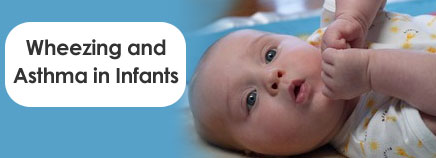
Millions of kids under the age of 18 have asthma. Most develop symptoms by age 6; some do as young as by age 3.
Asthma is becoming more common in developed countries, though no one knows exactly why. But researchers are sure of one thing: Kids are more likely to develop asthma if there’s a family history of allergies and asthma. This is especially true if a child’s parents have asthma and certain allergies. (Some allergies, such as to penicillin or insect stings, don’t affect the risk of asthma.)
My Baby Is Wheezing. Is It Asthma?
If your baby has a cold and is wheezing, you might wonder if the problem is asthma. But it’s not always clear if an infant has asthma. More important than getting a firm diagnosis is making sure your child gets treated for any breathing problems.
Asthma is a chronic disease of the lungs that causes the airways to swell, tighten, and produce excess mucus. It can be difficult to diagnose in children under the age of 5, especially in infants, because other conditions have similar symptoms.
It’s also difficult to accurately measure babies’ lung function (how well they breathe). Older kids and adults are better able to cooperate with lung function tests, which often involve taking a deep breath and blowing out as fast as the person can. This type of testing may show asthmatic changes in the lungs.
The mechanics of a baby’s lungs also complicate the diagnosis of asthma. Infants’ airways are small. When a baby gets a respiratory tract infection, these already small passages get swollen and filled with mucus much more easily than an older child’s or an adult’s. This can lead to coughing, wheezing, and other symptoms of asthma (even if it is not asthma, but just a viral infection).
Bronchiolitis and RSV
One common condition that mimics asthma in infants is bronchiolitis, which is usually caused by a viral infection, most commonly respiratory syncytial virus (RSV).
The infection affects the tiny airways called bronchioles. The airways swell, making breathing difficult. Infants are often affected because their airways are so small that they become easily blocked.
Symptoms of bronchiolitis include rapid breathing, a cough, wheezing, and fever. Infants who develop bronchiolitis may be more likely to develop asthma later in life. But it’s unclear if that’s because RSV infection causes asthma or because the child was born with a tendency to wheeze and was therefore more prone to both bronchiolitis and asthma. Studies are being done to clarify the relationship between bronchiolitis and the later development of asthma.
Less common reasons for wheezing in infants include:
- a foreign object or piece of food inhaled into the lungs
- premature birth — preemies who have insufficiently developed airways may wheeze
- cystic fibrosis — this disease can cause wheezing, too, but usually involves additional symptoms, such as delayed growth
Delaying Asthma Diagnosis
It’s important to remember that just one instance of wheezing isn’t enough to diagnose asthma. It must happen more than once.
But even when wheezing happens on a recurring basis, a doctor may still not be certain the cause is asthma, especially in young children. More time, and sometimes more tests, may be needed to confirm the diagnosis and decide on the best long-term management plan.
Doctors want to avoid an incorrect diagnosis, which might unnecessarily disrupt the lives of the entire family or label a child with a chronic condition he or she may not have. Fewer than one third of all infants who wheeze on a recurring basis during their first 3 years continue to wheeze into later childhood. In other words, most kids who wheeze as infants outgrow it and don’t have asthma when they get older.
However, doctors know that uncontrolled and persistent asthma can damage the lungs over time. The early use of anti-inflammatory medications might help prevent this from happening.
For these reasons, doctors might choose to treat the symptoms as if the child has asthma, even if the diagnosis is uncertain. They may prescribe asthma medications, but probably won’t officially diagnose a child with asthma unless symptoms continue.
Diagnosing Asthma in Older Babies
You should talk to your doctor about possible asthma if your child has:
- wheezing that has happened more than once (with or without illness)
- constant or bouts of coughing that get worse at night or after active playing
- any other breathing problem that concerns you
The doctor also may ask you whether your child has breathing problems in different circumstances, such as during a cold, or when exposed to:
- cold air
- allergens, such as pets or dust
- smoke
It’s important to tell the doctor about any family history of allergies, asthma, and sinus problems. This information and careful observation of your child over time will help the doctor decide if the symptoms are due to asthma or some other problem.
Treating the Symptoms
Just because the doctor doesn’t diagnose asthma doesn’t mean your child can’t be treated for wheezing. The doctor might prescribe inhaled asthma medications to see if the symptoms improve.
Because these medicines are generally safe, even for use in infants and young children, the possible benefits of a trial of asthma medications usually outweigh the risks of side effects.
Asthma medicines are often delivered using an inhaler with a spacer or through a nebulizer. The severity of the breathing problems, as well as how often symptoms occur, will help determine which kind of medicine is best for your child. The doctor also will consider whether your child needs continuous treatment or if medicine should be given only when symptoms occur.
You also should review the treatment plan with anyone who takes care of your child. Be sure that caregivers understand the plan and, if your child needs asthma medicine, teach them and family members how to use the inhaler or nebulizer.

